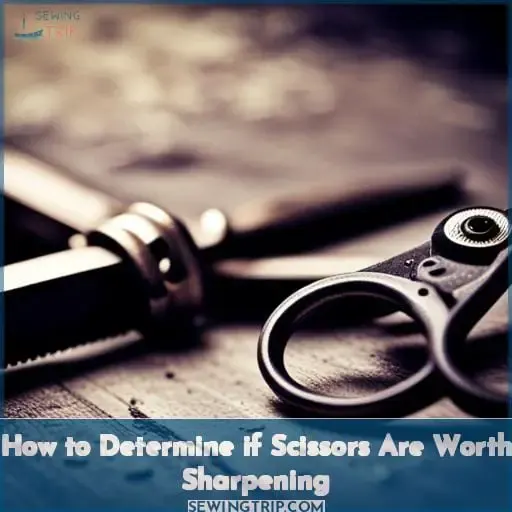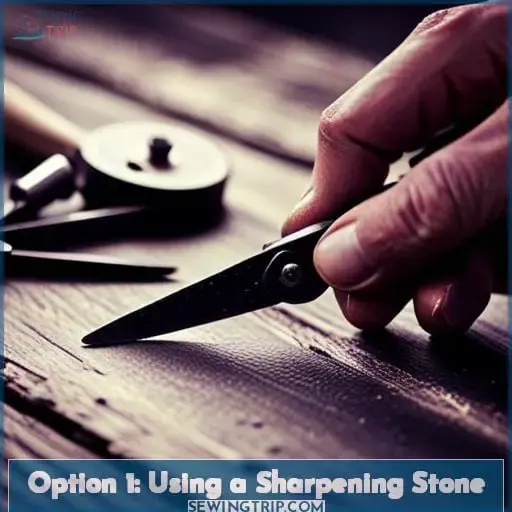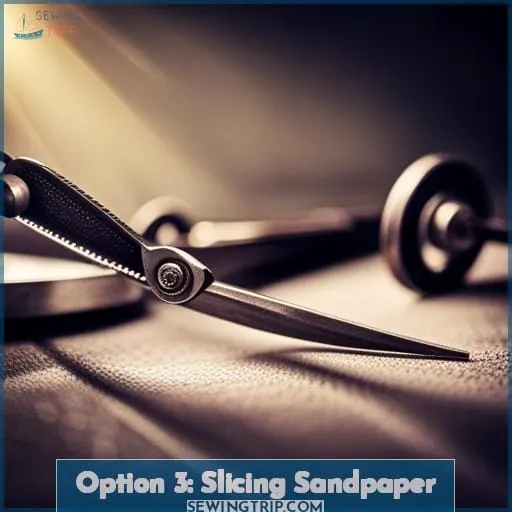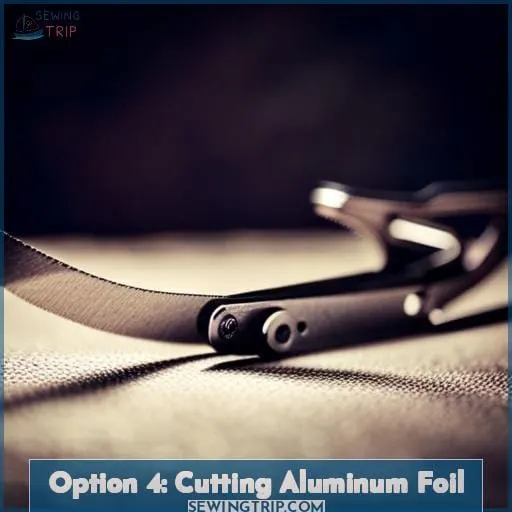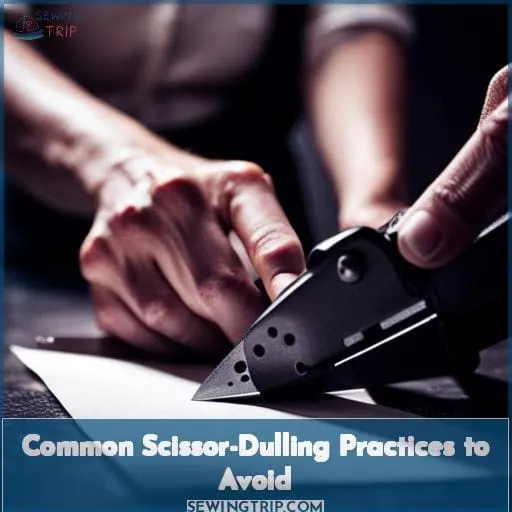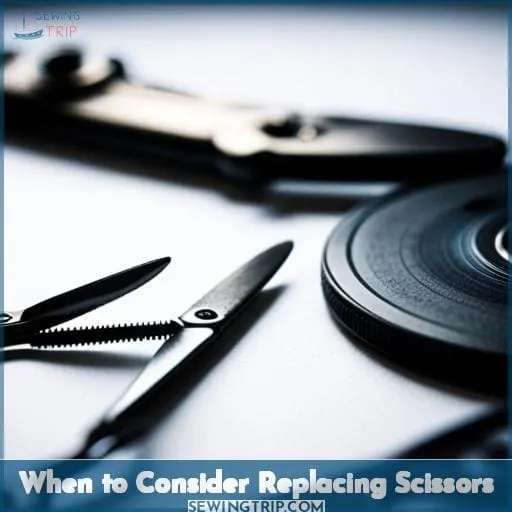This site is supported by our readers. We may earn a commission, at no cost to you, if you purchase through links.
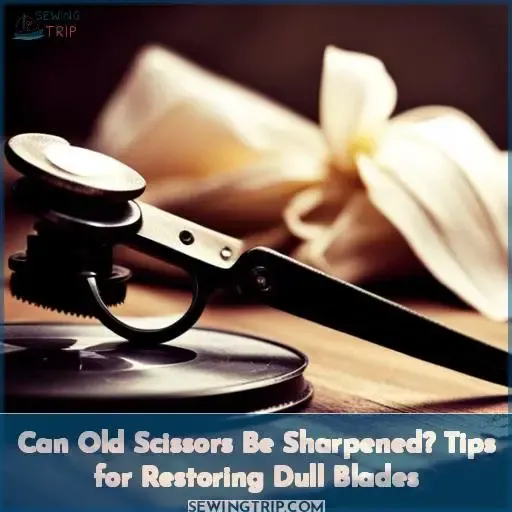 Imagine holding a pair of old scissors in your hands, their blades dull and lifeless. But don’t despair! With the right techniques, you can restore these trusty tools to their former sharpness.
Imagine holding a pair of old scissors in your hands, their blades dull and lifeless. But don’t despair! With the right techniques, you can restore these trusty tools to their former sharpness.
In this article, we’ll explore whether old scissors can be sharpened and provide you with tips for revitalizing those worn-out blades. Whether you’re a craftsperson seeking mastery or an aspiring tailor yearning for control over your cuts, get ready to uncover the secrets of restoring dull scissors to their full potential.
Table Of Contents
- Key Takeaways
- Can Old Scissors Be Sharpened?
- How to Determine if Scissors Are Worth Sharpening
- Option 1: Using a Sharpening Stone
- Option 2: Using a Rotary Tool
- Option 3: Slicing Sandpaper
- Option 4: Cutting Aluminum Foil
- Common Scissor-Dulling Practices to Avoid
- When to Consider Replacing Scissors
- Frequently Asked Questions (FAQs)
- Conclusion
Key Takeaways
- Assess scissor blades for visible damage prior to sharpening
- Use a coarse sharpening stone with lubricant to restore cutting edges
- Clamp scissors securely and use a rotary tool for more uniform sharpening
- Fold sandpaper to sharpen scissor blades through repeated slicing motions
Can Old Scissors Be Sharpened?
Yes, you can sharpen old scissors with the right techniques and tools. Whether you have fabric shears, paper scissors, or kitchen snips, there are various methods to restore their sharpness.
To begin the sharpening process for your old scissors, gather a honing steel or a sharpening stone. These tools will help remove any burrs from the blades and give them back their cutting edge.
Before starting to hone your old scissors blades on either tool of choice, make sure that they’re clean and dry as this will prevent any debris from interfering with the sharpening process.
Now that we’ve covered safety tips, let’s move onto how often one should be doing this task: typically once every three months, but if dullness persists then try more frequently until desired results are achieved!
Now that you understand how frequently to perform scissor maintenance, let’s delve into using honing steel first. Take your time when sliding the blade across its surface, making 10-20 passes per side, ensuring equal pressure is applied throughout the movement so no one area becomes overworked! Once finished, flip over the blade, repeat the same number of strokes opposite, applying even force again, then carefully wipe off excess metal particles residue left behind by cleaning cloth or towel.
Using a different approach, now grab hold of either coarse grit sandpaper or fine-grit variety, depending upon the severity of damage inflicted upon older pair. Fold the piece half lengthwise, gripping only the ends, leaving the middle exposed, creating a makeshift handle which grasp at all times while working the edges.
Be cautious not to cut yourself during an improper grip; a slip up could lead to injury instead of success. Sharpener beware, potential jar damage resulting from improper technique. Always remember to keep gloves and goggles handy to protect against flying sparks and shavings.
Always take caution when handling power equipment. Lastly, never forget the importance of proper storage in a closed container to avoid accidental nicks.
How to Determine if Scissors Are Worth Sharpening
To determine if your old scissors are worth sharpening, you should assess the condition of the blades and their cutting ability.
- Blade Condition:
- Check for any visible signs of damage such as chips or cracks in the blades.
- If they’re severely damaged, it may not be worth sharpening them.
- Cutting Ability:
- Test how well the scissors cut through various materials like fabric or paper.
- If they struggle to make clean cuts or snag on the material, it’s a sign that they need sharpening.
- Scissor Type:
- Different types of scissors have different requirements for sharpening.
- For example, pinking shears have serrated edges that require special tools and techniques for proper sharpening.
- Sharpening Frequency:
- Consider how often you use your scissors and when was their last sharpening session.
- Regularly used scissors will benefit from more frequent maintenance to ensure optimal performance.
- Burr Removal:
- Inspect the blades closely for any burrs – small metal protrusions formed during use or previous attempts at sharpness restoration.
- Removing these burrs is essential before proceeding with a full-blown scissor-sharpening session.
Option 1: Using a Sharpening Stone
Once you’ve determined that your scissors are worth sharpening, you can utilize a sharpening stone to restore the blades.
Sharpening stones come in various grits, and for dull scissors, it’s best to start with a coarse side around 400 grit.
Before beginning the process, make sure to lubricate the stone with water or honing oil.
To sharpen each blade of your scissors, draw it smoothly across the length of the stone using light pressure and consistent strokes.
After using the coarse side of the sharpening stone, flip it over to its finer side which is typically around 1000 grit. This will help refine and polish your scissor blades even further. Once again, stroke each blade across this fine surface several times.
When finished sharpening both sides of each scissor blade on their respective sides of
the honed tool (with coarser grain first then moving on progressively finer grains like an artisan), check for any remaining burrs along
the inner edge by lightly stroking them against one another while maintaining focus on precision control mastery.
Option 2: Using a Rotary Tool
Now that you’ve learned about using a sharpening stone to restore the sharpness of your scissors, let’s explore another option: using a rotary tool. This method provides an efficient and precise way to sharpen your blades, ensuring they’re ready for all your cutting needs.
When utilizing a rotary tool for scissor sharpening, it’s crucial to prioritize safety by following proper precautions.
Here’s how you can effectively use a rotary tool:
- Clamp securely: Begin by securely clamping the scissor blade in a vise with the beveled edge facing up.
- Choose appropriate bits: Fit the appropriate grinding stone bit into your rotary tool.
- Maintain control: Hold onto the rotary tool firmly with both hands while working on each blade.
- Sharpen carefully: Using light strokes, gently stroke along the beveled edge of each blade until re-cutting its shape and removing any dullness or imperfections.
By employing these steps correctly and taking necessary precautions such as wearing protective gear and avoiding burrs during this process ,you can confidently utilize this versatile power-tool-based approach to bring back optimal sharpness to your scissors.
Option 3: Slicing Sandpaper
When sharpening old scissors, another option to consider is slicing sandpaper along the full length of the blade.
Start by folding a sheet of coarse grit sandpaper, around 150-200 grit, in half so the abrasive side is out.
Then, slice through the sandpaper using the entire length of the scissor blade in long, full strokes.
The grit particles along the folded edge of the sandpaper will gently hone and sharpen your cutting edge.
You may need to repeat this slicing motion multiple times to achieve your desired level of sharpness.
Make sure to wipe the scissor blades clean after slicing to remove any sandpaper grit residue.
Slicing sandpaper can breathe new life into your dull old scissors in a simple, effective way.
Test the sharpness on a scrap piece of paper after sharpening. If the blades slice cleanly, your trusty scissors are ready to precisely cut fabric and materials once again.
Option 4: Cutting Aluminum Foil
To sharpen old scissors, you can achieve good results by cutting aluminum foil.
Take a piece of aluminum foil and fold it four to six times to create layers that provide the necessary thickness for effective sharpening. The folds in the foil will help create friction against the blades as you cut through them, honing their sharpness with each pass.
Hold your scissors firmly and make full-length edge strokes into the strips of folded aluminum foil. The particles from the foil gently hone the cutting edge of your scissors, gradually restoring their sharpness.
Remember to wipe off any residue left behind by the aluminum foil after sharpening is complete so that it doesn’t interfere with future use or cause any damage over time.
Using this method allows you to easily restore dull blades without investing in specialized tools or materials—just some common household items like aluminum foils can do wonders for bringing back sharpness to your beloved shears!
Common Scissor-Dulling Practices to Avoid
Avoid these common practices that can dull your scissors and hinder their cutting performance.
Firstly, refrain from using your fabric scissors to cut paper or cardboard. The rough fibers of paper and the abrasive texture of cardboard will quickly wear down the sharpness of your scissor blades.
Secondly, resist the temptation to use your hair-cutting shears for any purposes other than cutting hair. Hair contains natural oils that can transfer onto other materials such as tape or fabric, causing them to stick together and making it difficult for the scissors to glide smoothly through them.
Lastly, avoid putting excessive pressure on your scissors when cutting tough materials like thick layers of fabric or heavy-duty tape. This can cause unnecessary strain on the blade edges and lead to premature dulling.
By avoiding these detrimental practices in caring for your scissors, you’ll prolong their lifespan and maintain optimal cutting efficiency across various tasks such as trimming fabrics with precision, cleanly slicing papers without frayed edges, effortlessly shaping hairstyles with professional-grade shears – all while ensuring a smooth experience every time you reach for those trusty pair of blades in hand.
When to Consider Replacing Scissors
As a skilled craftsperson, you know that even the highest quality scissors will eventually show signs of wear and tear.
When considering whether to replace your trusty pair of scissors or attempt to sharpen them, there are a few key factors to keep in mind.
Look for worn blades that no longer cut smoothly or cleanly, as this is a clear indication that it may be time for new ones.
However, if the blades can still be restored through sharpening and regular maintenance has been maintained over time, there’s no need to rush into replacing them just yet.
Signs of worn blades
If your scissors are showing significant signs of wear, such as frequent snags or difficulty cutting through materials, it may be time to consider replacing them.
- Rust or pitting on the surface of the blades.
- Visible burrs along the edges of the scissor blades.
- Uneven edges that no longer meet properly when closed.
- Uneven cuts where one side of the scissors is duller than the other.
Remember to inspect all types of scissors, including kitchen shears and poultry shears, especially if you’ve purchased them from a flea market where their history is unknown. Additionally, pay attention to serrated scissors which can easily become blunt with use and require sharpening or replacement sooner than regular ones.
When sharpening is needed
When your scissors no longer cut smoothly or struggle to slice through fabric and paper, it’s time to consider sharpening them. Dullness affects the sharpness of the scissor’s edge, making it difficult to achieve clean cuts.
By sharpening the metal blades, you can restore their cutting ability and ensure precise results in your crafting or tailoring projects.
Importance of regular maintenance
Regular maintenance is key in extending the lifespan of your scissors. Here are some important practices to keep in mind:
- Keep blades clean to prevent debris buildup.
- Avoid nicks and damage by handling with care.
- Prevent rust by drying thoroughly after use.
- Store properly, closed and protected, to avoid accidental dropping.
Frequently Asked Questions (FAQs)
How often should I sharpen my scissors?
Sharpen your scissors when they start to feel dull and struggle to cut smoothly. Regular sharpening maintains their performance. A well-sharpened pair of scissors will give you precise, effortless cuts for all your crafting or woodworking needs.
What are the best scissors that stay sharp the longest?
To ensure your scissors stay sharp for longer periods, opt for high carbon steel blades.
These durable tools are designed to withstand heavy use and retain their keen edge over time.
Invest in quality craftsmanship that lasts.
Is it safe for kids to use sharpened scissors?
Yes, it’s safe for kids to use sharpened scissors.
Ensure they’re supervised and taught proper handling techniques.
Sharpening scissors improves their cutting ability, making them safer to use.
Can I sharpen pinking shears or embroidery scissors?
Absolutely! Pinking shears and embroidery scissors can be sharpened.
Use a saw file with a fine cut to bring back their sharpness.
Take your time, apply gentle pressure, and soon they’ll slice through fabric like new again.
What’s the most cost effective way to keep all my scissors sharp?
To keep all your scissors sharp, regularly sharpen them with a saw file. It’s cost-effective and easy to do at home or in the workshop. With just a minute of your time, you can maintain their cutting power for years to come.
Conclusion
Like an old friend, those tired scissors have served you well. Yet even the most loyal companions need care.
With a little elbow grease and some sharpening know-how, you can breathe new life into those dull blades.
Tend to them as you’d a budding sapling, helping their edges grow keen again.
Before long, your tools will be pruning as precisely as the day you first snapped them shut.
Yes, with dedication and skill, even the oldest pair of scissors can be sharpened.

